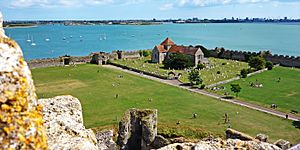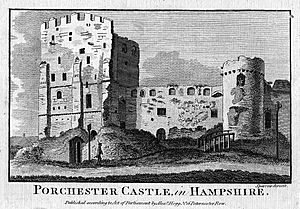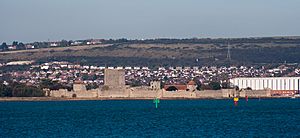Portchester Castle facts for kids
Quick facts for kids Portchester Castle |
|
|---|---|
| Portchester, Hampshire | |

The inner bailey
|
|
| Coordinates | 50°50′12″N 1°06′47″W / 50.836546°N 1.113034°W grid reference SU624045 |
| Official name | Portchester Castle |
| Designated | 13 January 1915 |
| Reference no. | 1015698 |
|
Listed Building – Grade I
|
|
| Official name | Portchester Castle |
| Designated | 18 October 1955 |
| Reference no. | 1229190 |
Portchester Castle is an old fortress built inside the walls of a Roman fort. It stands in Portchester, a town in Hampshire, England. The castle's main tower, called the keep, was likely built in the late 1000s. At first, it was owned by a powerful lord.
In 1154, the castle became a royal property, meaning it belonged to the King of England. Kings used it as a favorite hunting lodge. It was even captured by the French in 1216, but the English quickly took it back.
Portchester was an important port in the Middle Ages because of its great location at the top of Portsmouth Harbour. English kings often started their trips to France from here. In the early 1300s, King Edward II spent a lot of money to fix and strengthen the castle. This was because people worried about a French invasion.
A famous plot to overthrow King Henry V was discovered at Portchester Castle. This event is even in William Shakespeare's play Henry V. Much later, the castle was used as a prison.
Today, Portchester Castle is a Scheduled monument, which means it's a very important historical site. It's also a Grade I listed building, showing its special architectural value. The castle has been owned by the Southwick Estate since the 1600s. However, English Heritage manages it, and it's open for visitors all year. A very old church, St. Mary's, stands inside the castle grounds.
Contents
The Castle's Early History
People have known how important Portchester's location is since at least the 200s AD. That's when the Romans built a fort there. We don't know the exact year it was built. But it's thought that Emperor Diocletian ordered it to be built between 285 and 290 AD. This fort was one of many built along the British coast. Their job was to stop pirate raids. Portchester was probably a base for the Roman navy that protected Britain. It is the best-preserved Roman fort north of the Alps mountains.
The Roman army left Britain in the early 400s. But the fort was probably never completely empty. It was still used, just on a much smaller scale. In the 900s, a hall and tower were found inside the fort. This suggests it was a fancy home during the Saxon period. In 904, King Edward the Elder took control of Portchester. The fort became a "burh," a fortified town, to help defend against Viking attacks. This is listed in an old document called the Burghal Hidage.
Building the Medieval Castle
We're not sure exactly when Portchester Castle was built. But it was probably in the late 1000s. After the Normans took over England, the land of Portchester was given to William Maudit. He was a friend of William the Conqueror and a powerful lord. He likely built Portchester Castle.
We don't know exactly what this first castle looked like. But Maudit probably created the inner part of the castle, called the inner ward. This was in the north-west corner of the Roman fort. At that time, it was likely protected by a wooden fence and a ditch. The original Roman stone walls of the fort would have protected the outer part, called the outer bailey. Maudit died around 1100. His property then went to his son, Robert Maudit. Robert died in 1120. A few years later, the family's lands went to William Pont de l'Arche through marriage.
The castle was probably rebuilt in stone around this time. The stone used looks like the stone in St. Mary's parish church. This church was built in the 1130s in the outer bailey. Pont de l'Arche built the church for a group of monks called Augustinians. They started a priory, a type of monastery, inside the castle in 1128. Other buildings were planned for the priory. But almost no trace of them remains. The monks moved to a new place between 1147 and 1150. So, the buildings might never have been finished.
William Pont de l'Arche probably owned Portchester Castle until he died in 1148. We don't know for sure who inherited it next. It might have gone to William Maudit, a relative of the first owner. Or it could have gone to Henry Maudit, William de l'Arche's son. The first clear mention of the castle is from 1153. In that year, Henry Plantagenet, who later became King Henry II, gave the castle to Henry Maudit.
A Royal Castle
When Henry II became king in 1154, he took control of Portchester Castle. It stayed under royal control for several centuries. More records exist from when the castle was owned by the king. These royal records tell us about the castle's condition. For example, not much money was spent on the main tower (the keep) during the king's time. This suggests it was mostly finished. In 1183, records show there were royal apartments separate from the keep.
King Henry II often visited Portchester. It was part of his disagreement with Thomas Becket, a powerful church leader. Henry met with a bishop from France at the castle to discuss Becket. The castle was also used to hold important prisoners, like the Earl of Leicester. When Henry II's sons rebelled against him in 1173–1174, Portchester was made ready for war. To defend the castle, catapults were built. Ten knights were sent to guard it, and later that number increased to 20.
King John often stayed at Portchester Castle. He was there when he heard that England had lost control of Normandy in France in 1204. The Forest of Bere was nearby, making Portchester a popular place for the king to relax and hunt. Portchester was also the starting point for trips to France in 1205 and 1213. King John tried to get Normandy back from the French king, but he failed.
After signing the Magna Carta in 1215, King John asked the pope to cancel it. As a result, his opponents were removed from the church in September. At this point, John attacked Rochester Castle. The rebels then asked France for help. The English lords offered the throne to Prince Louis, the French king's oldest son. Louis's plan worked well at first. He captured London and Winchester. Portchester Castle surrendered to his forces in June 1216.
King John died on October 19, 1216. Nine days later, his oldest son was crowned King Henry III. Louis's luck changed, and Portchester Castle was taken back by the English in the spring of 1217. There was a standoff between Henry III and Louis until the English won a big battle in May. After his supplies from France were cut off in August, Louis was paid to leave England. Henry tried to get Normandy back, but problems in England forced him to give up in 1259. Portchester was often where troops left for these campaigns.
For most of the 1200s, not much attention was paid to the castle's defenses. But near the end of the century, a wooden tower was built to make the eastern Roman wall stronger. During the time of King Edward II (1307–1327), people expected a French invasion. So, soldiers were stationed at Portchester. The King spent over £1,100 fixing and strengthening Portchester Castle between 1320 and 1326. The buildings in the inner ward were updated, and the outer gatehouses were made bigger.
Even with all the expensive work by Edward II, a report from 1335 said that many of the castle's buildings were falling apart. It also said the south wall of the Roman fort was damaged by the sea. King Edward III didn't stay at Portchester often. But in June 1346, he gathered his army of 15,000 soldiers there. They then left for France on a trip that ended with a victory at the Battle of Crécy.
More work was done in the 1350s and 1360s. The living areas inside the castle were reorganized, and the sea wall was fixed. Between 1396 and 1399, the royal apartments that you can still see today (though they are ruins) were built for King Richard II.
In 1415, King Henry V was getting ready at Portchester Castle for a trip to France. This was part of the Hundred Years' War between the two countries. While at Portchester in July, a secret plan to overthrow Henry was discovered. This was called the Southampton Plot. At the castle, he arrested the people involved: Richard of Conisburgh, 3rd Earl of Cambridge, Henry Scrope, 3rd Baron Scrope of Masham, and Sir Thomas Grey. All three were executed in early August.
In the 1400s, the nearby town of Portsmouth, about six miles away, grew into a very important port and economic center. It took over from Portchester as a military base. Because of this, Portchester Castle started to decline. A report from 1441 said the castle was "right ruinous and feeble" (very ruined and weak). Even so, when Margaret of Anjou, the wife of King Henry VI, arrived in England in 1445, Portchester Castle was chosen as her arrival port.
The castle continued to be neglected until the late 1400s, when efforts were made to repair its buildings. When King Henry VIII visited with Queen Anne Boleyn in October 1535, it was the first time in over a hundred years that the current king or queen had been to the castle.
Between October 1562 and June 1563, the English army occupied the port of Le Havre on France's northern coast. During this time, Portchester Castle was used as a military hospital for soldiers involved in the conflict with France. As relations with Spain got worse, Queen Elizabeth I prepared Portchester Castle for war. She expected a Spanish invasion. At that time, Henry Radcliffe was in charge of the castle.
On August 30, 1591, Queen Elizabeth visited the castle. But the floors of the fancy royal rooms were rotten. So, she had dinner in the keeper's bedroom instead. Instead of her usual sweet perfumes, the room was made fresh with plants like rue and hyssop. By 1603, the castle was in good enough shape for Elizabeth to hold court there. Sir Thomas Cornwallis was put in charge and updated the buildings along the eastern side of the inner bailey. A royal report from 1609 shows the castle's improved condition. It noted that the buildings Cornwallis built had "four fair lodging chambers above and as many rooms for office below."
Used as a Prison
The castle stopped being royal property in 1632. King Charles I sold it to Sir William Uvedale. Since then, Portchester Castle has been passed down through his family, the Thistlethwaites. The castle didn't see fighting during the English Civil War. But for a short time in 1644, it was guarded by Parliamentarian soldiers.
One common use for castles was as a prison. From the late 1600s onwards, this became Portchester's most important job. In 1665, 500 prisoners from the Second Anglo-Dutch War (1665–1667) were held at the castle. Some were kept in the church in the outer bailey. They damaged the building by setting it on fire. The church wasn't fixed until about 40 years later. Between 1702 and 1712, the King rented Portchester Castle from the Uvedale family. This was to hold prisoners from the War of the Spanish Succession. The first detailed reports about the prisoners' living conditions came from the mid-1700s.
The castle was last used as a prison in the 1800s. Over 7,000 French prisoners from the Napoleonic Wars were held there. Hospital Lane, which is next to the west side of the castle, was where the prison hospital was located. This building still exists today as a private home. Prisoners who died were often buried in what are now muddy areas south of the castle. Sometimes, storms uncover their remains.
Portchester Castle Today
Today, Portchester Castle is open to visitors. It's also used for fun activities. The inner part of the castle has displays and exhibits. The castle is a popular place for school trips. At high tide, people often fish for flounder and bass from the sea wall. The castle buildings are cared for by English Heritage.
Local Legends
A local story says that Pontius Pilate, a Roman official, was brought here by boat late in his life. The legend says he found his final safe place at Portchester.
See also
 In Spanish: Castillo de Portchester para niños
In Spanish: Castillo de Portchester para niños
- Constable of Portchester Castle
- Castles in Great Britain and Ireland
- HMS Portchester Castle
- List of castles in England








